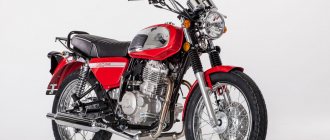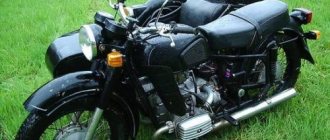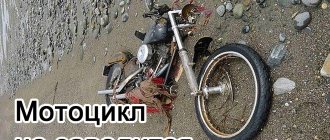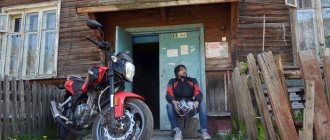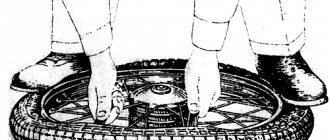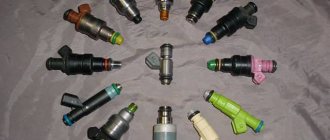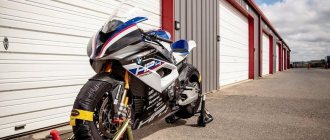Rate this post
A popular brand of motorcycles in the Union was “Minsk”. The assembly of motorcycles under this brand was carried out by specialists from the Moscow Helicopter Plant OJSC Motovelo. The first copy of the motorcycle was born back in 1951. Today it is a private enterprise that assembles motorcycles of various categories - classic models, cross-country, enduro, street. On the roads there are old copies produced several decades ago. Today it is already more of a rarity, they want on the secondary market there are offers to buy the legendary Minsk motorcycles, but basically, their technical condition leaves much to be desired.
Finding a truly “living” specimen is a rather difficult task. At one time, “Minsk” made a lot of noise due to its good performance qualities. In addition, the same “Minsk-125” was much easier to get than “Ural” or “Voskhod”, plus it was cheaper. Due to its technical characteristics, it was used as the main means of transportation on the roads of the Union, and sometimes as a “workhorse” in the village.
Start
After World War II, documentation and equipment from the German DKW plant in Tschopau were exported to the USSR as war reparations. The production of the DKW RT 125 model began in Moscow under the M1A brand.
By order of the Ministry of Automotive and Tractor Industry of the USSR No. 494 dated July 12, 1951, the production of the M1A motorcycle was transferred from Moscow to the Minsk Motorcycle and Bicycle Plant). M1A became the basis for simple and reliable classic Minsk motorcycle models, the history of which continues to this day.
The lineup
Now the plant in Minsk specializes in the production of three types of motorcycles:
- classic – C 125, C4 125, C4 200, D4 125, M 125 and M 125X;
- enduro (for off-road driving) – TRX 300i, X 200, ERX 250;
- street (sports motorcycle for city driving) – R 250, C4 250, CX 200.
At the moment, the most affordable and popular are the following Minsk motorcycle models:
- C 125;
- D4 125;
- M 125.
All of these models have an engine capacity of 125 cubic centimeters to achieve the maximum balance of performance and efficiency.
Minsk S 125
This model is considered basic. The motorcycle is considered an SUV, so most Minsk motorcycles are produced on its basis. For off-road driving, the motorcycle is equipped with high-strength rubber, with which the warrior can reach speeds of up to 60 km per hour.
Engine with two strokes and one cylinder. This power unit is enough for a comfortable ride. Over 100 kilometers traveled, the motorcycle will “eat” 3 liters of gasoline. When traveling over rough terrain, this figure will increase to 4 liters.
The engine is started using a kickstarter. This system provides reliability in all weather conditions.
Many users mistake the C 125 for a moped. This is facilitated by its small dimensions and two-stroke engine.
Watch a video review of the Minsk S 125 motorcycle:
Minsk D4 125
The power unit is also with one cylinder, but with four strokes. The model belongs to the sports category. The number of revolutions that the motorcycle produces allows you to maintain high speed driving for a long period of time.
The maximum speed is 100 km per hour. For quick acceleration, a gearbox with five gears is installed. Gasoline consumption per 100 km of driving will be only 2.6 liters. A big plus is the presence of an electric starter.
The vehicle weight is 100 kg. Many drivers consider the presence of a welded footrest for passengers to be a disadvantage, because it cannot be removed.
Watch a video review of the Minsk D4 125 motorcycle:
Minsk M 125
M 125 is the most popular model in the company's line of motorcycles. This success is based on low maintenance. Many users say that the M 125 is simply impossible to kill.
The motorcycle has a single cylinder, two stroke engine. Fuel consumption is also minimal: over 100 kilometers traveled, the gas tank will be empty by 2.5 liters.
The standard version is equipped with drum brakes, which can be replaced with disc brakes. As an additional option, you can order a stroller for carrying cargo. Model weight – 122 kg.
Watch a video review of the Minsk M 125 motorcycle:
MMVZ
Minsk motorcycles were rapidly gaining popularity both in the USSR and in foreign markets. Their deliveries were made to 45 countries, and the total number exceeded 6.5 million.
From the very first years, the brand has been actively involved in motorsports, mainly in cross-country and circuit racing. The first cross country “Minsk M-201K” and enduro “M-201M” were created in 1956. Three samples of the first highway-ring ShK-125 with a record 23-horsepower engine for that time were produced in 1961. A decade later, the first road racing motorcycle with a developed fairing, the M-211, appeared, followed by the MMVZ-3.216 (1977) and MMVZ-3.227 (1986).
Significant milestones in the history of Minsk motorcycles were the Minsk-Pamir (1969) and Brest-Vladivostok (1971) motorcycle races.
A new model designation system, developed by the VNII-Motoprom of the USSR, was introduced in 1973 on the new Minsk MMVZ-3.111, which received the USSR State Quality Mark:
MMVZ - manufacturing plant;
3 - motorcycle class (up to 125 cm3);
1 — type of motorcycle (road);
11 - serial model number.
The reliability and unpretentiousness of Minsk motorcycles have made the Minsk brand iconic in Vietnam, which has become the largest export market. Vietnamese motorcycle fan club Minsk since 1988. holds gatherings for fans of the brand, which annually attract more than a thousand people. On the set of the Top Gear Vietnam Special, the Minsk motorcycle was driven by Richard Hammond.
By the early 1990s, motorcycle production had increased to 220,000 units per year. In 1999, the Minsk brand received the Arch of Europe Award for its approval in the international market.
Specifications
Technical indicators should be divided into two categories: external and internal.
External characteristics
The length of the motorcycle is 2.1 meters. The height is 1.2 meters with a distance between the axes of 1.32 meters. The size of the rudder line is 0.8 meters. The ground clearance is 12.5 cm.
The Minsk motorcycle reaches a maximum speed of 95 km per hour with a maximum permissible passenger weight of 165 kg.
Internal characteristics
The power unit of the Minsk motorcycle has always been unpretentious in operation, remaining extremely reliable even by modern standards.
The motorcycle engine is gasoline-based, with one cylinder, the diameter of which is 0.52 cm. The piston stroke is 0.58 cm with an engine displacement of 125 cc. see. Maximum engine power is 12 horsepower at 6.9 thousand rpm.
The motorcycle has always been distinguished by high-quality compression, the degree of which is 10.5. The motorcycle is powered by a K-62C carburetor with an air cooling system.
The motorcycle has a four-speed gearbox with a foot shift mechanism.
It is recommended to use 76 grade gasoline as fuel in a proportional ratio of 25 to 1 with engine oil. Fuel consumption averages 3.5 liters per 100 km.
M1NSK
In 2007, Motovelo became a private enterprise. New street and touring-enduro class models, as well as scooters, ATVs and snowmobiles, are offered that meet modern requirements.
In 2010, a new logo and spelling M1NSK were introduced, echoing the name of the brand's first motorcycle. Also, today’s model designation system was introduced, which meets the established world standard and is easier to understand:
C—model code;
4 — four-stroke engine;
250 - engine displacement.
In 2013, together with the CSTO, the Brest-Dushanbe motorcycle rally was held on three M1NSK TRX 300 with a total length of 10,000 km. In 2014, M1NSK received the People's Brand award.
Price
Minsk motorcycles have always been available at an average price. At the moment, the average cost of a motorcycle is 75 thousand rubles, but modified versions can cost 150 thousand rubles.
Almost 70 years after the launch of production of the first motorcycles, the Minsk company continues to remain among the leaders in manufacturers of high-quality and inexpensive motorcycle equipment. At the moment, Minsk brand motorcycles are produced in three modifications.
Gregory
Blog author
Photo gallery
Well, in conclusion of everything written above, we offer you a selection of photos of these Belarusian beauties. They will be a great purchase for a novice biker and will not put a big dent in your pocket.
Modern, simple and convenient D4 125
The D4 125 is a simple, comfortable and modern motorcycle.
A single-cylinder four-stroke engine with a power of 10.5/8000 (hp/rpm) will easily accelerate the bike to 100 km/h. The basic kit includes both an electric starter and a kick starter. Quite economical fuel consumption, about 2.6 liters.
The gearbox is easy to use, everything works easily and smoothly.
There are passenger footrests, although they are welded on, so even if you drive alone, you can’t get rid of them.
| Working volume (cc.cm) | 125 |
| engine's type | vertical, 1-cylinder, 4-stroke |
| Power(hp/rpm) | 10,5/8000 |
| Startup type | electric starter, kickstarter |
| Cooling | air |
| Number of gears | 5 |
| Maximum speed (km/h) | 100 |
| Front tire/brake | 3.0x18″/single-disc hydraulic |
| Rear tire/brake | 3.0x18″/B |
| Length (mm) | 2100 |
| Height (mm) | 1110 |
| Width (mm) | 770 |
| Dry mass (kg) | 100 |
| Fuel | not lower than A-92 |
| Tank capacity (l) | 12 |
| Available bike color | red, blue and black. |
Description of the technical characteristics of the Ural Wolf motorcycle, it became the first chopper to be produced in Russia.
We bring to your attention a small photo selection of various models of ATVs from the Japanese manufacturer Honda.
MY MOTORCYCLE
Minsk, or in common people “Makaka” - probably many began their journey in biker life with this motorcycle.
You could see him everywhere. Economical, simple, not expensive and small, that’s how you can describe it. By the way, my first motorcycle that I learned on was a Makaka. Now her relative is lying in my attic, I can’t find time for her. “Soviet motorcycles produced after 1945 have perfect engines, which can be started easily and quickly,” the instructor quoted memorizedly, without expression. He spoke for a long time. And the engine, overheated by training driving (a dozen cadets from the first group made it hot with inept starts and “crawling” in first gear) finally cooled down. And it started. That's what they wrote about him in one of the motorcycle magazines. Probably, for many, these motorcycles, which in the late forties and early fifties were the main training equipment in DOSARM and then DOSAAF motorcycle circles, are firmly ingrained in their memory. Uncomplicated, obedient, cute cars.
Who knows what their story is? Let's talk about this, but in order. The ancestors of modern Minsk began to be produced simultaneously in 1946 by two enterprises. These are the Moscow Motorcycle Plant (in the pre-war years - bicycle plant) and the Degtyarev Plant (ZID) in Kovrov. The first, let's call it MMZ for brevity, already had some experience in the production of motorcycles. In 1941, in cooperation with EIS (later called ZIL), which made engines, and with the KIM plant (AZLK), which supplied gearboxes, it produced M-72 vehicles. After the end of the war, he was entrusted with the production of the Ml A model, called “Moscow”. Design work on it was headed by S. Semashko. And in Kovrov, where the main products were associated with the name of weapons designer V. A. Degtyarev, in 1946 the production of civilian products began - motorcycles. To develop drawings of the K-125 model of the 125 cm1 class, a special design bureau was created under the leadership of N. Lopukhovsky.
Both in Moscow and in Kovrov they took the German motorcycle DKV-RT125 from 1940 as a basis. It was an advanced design for its time, and also very technologically advanced. Its creators wanted to see it as a Volkswagen motorcycle. The motorcycle was a harmonious combination of such technical solutions as an engine in a block with a gearbox, two-channel loop blowing of the cylinder, constant mesh gears in the gearbox, and gear shifting by pedal.
The DKW plant in Zschopau, located in the Soviet zone of occupation, was subject to dismantling by decision of the Allied authorities as an enterprise that supplied weapons to the Wehrmacht. Equipment, fittings, and technical documentation were taken to Moscow, Izhevsk and Serpukhov as compensation for damage caused by the enemy to the national economy of our country. Based on German drawings and technology, the M1A and K'125 motorcycles were born at MMZ and ZID, and already at the end of 1946, both enterprises launched their serial production. It must be emphasized here that soon after the end of the war, but two years later, our factories mastered production of models that were copies of the DKV-RTI 25, such well-known in the USA (since 1948), BSA in England (since 1948) and Yamaha in Japan (since 1954). The English BSA-D1 was a mirror copy of the German motorcycle: the reverse gear chain was located not on the right, but on the left, the gear shift mechanism moved to the right side, etc. And in the city of Zshopau (then already in the GDR) in the buildings of the former DKV plant The IFA enterprise (since 1956 it was called MC) began to produce IFA-RT125 motorcycles in 1948. And the branch in Ingolstadt (Germany) also resumed production of this model under the original name. Thus, by 1950, eight factories in seven countries were producing the same design. The Soviet counterparts Ml A and K-125 differed in some ways. And not just the emblems on the fuel tank. The differences mainly concerned electrical equipment. On the M1A, the ignition key and warning lamp were located in the headlight, and on the K-125, the reel, relay, ignition switch and other devices were located in one block - a black box under the seat. Otherwise, both cars were identical. The engine and gearbox were located in a common crankcase, which was “halved” like a walnut. The connector of the crankcase halves is vertical, longitudinal. The engine itself, although it had a cast iron cylinder, was quite light - 17.5 kg. This was achieved not only by the compact design, but also by the crankcase and cylinder head cast from aluminum alloy. Hermann Weber, under whose leadership the DKV-RT125 was created, decided to use a cast iron cylinder not only because of the low cost of the material. During casting, cast iron ensured good filling of the mold, and thus it was possible to ensure high accuracy of the configuration of the purge channels. But cast iron parts work well in compression. Therefore, Weber decided not to attach the cylinder to the crankcase with a flange and short studs, but rather the head with independent bolts. He turned to aviation practice: he connected the head and cylinder to the crankcase with long anchor pins, freeing the cast-iron cylinder from massive bosses and flanges. For a mass-produced low-cost model, the optimal solution turned out to be a two-channel loop blowdown according to Schnürle’s patent. With this design, there is no need to install a deflector ridge on the bottom of the piston, i.e., the piston becomes easy to manufacture. Today, for many motorcyclists, such pistons are a completely unfamiliar anachronism, but in the thirties, many two-stroke motorcycle engines still retained deflector scavenging. The air filter is in the spirit of the times: tiny by today's standards and very ineffective. It is not surprising that the piston rings sometimes had to be changed after 4 thousand km. One would not expect anything else from a filter consisting of a set of stamped meshes rolled into a metal body with a diameter of only 70 mm.
The noise level was not measured then, but subjectively the Ml A engine worked quite quietly. Almost everyone admired the graceful shape of the chrome exhaust pipe, bent in a parabolic curve. She dominated the appearance of the car. The M1A and K-125 engines ran on any type of gasoline (even A-661), and their compression ratio was only 6.25. Moreover, the engine characteristics were quite flexible: the engine developed the greatest power at 4800 rpm, and maximum torque occurred at 3400 rpm. In this case, only three gears in the transmission were quite enough. A very compact kickstarter and foot shift mechanism, and a small center-to-center distance (37.5 mm) of the gearbox shafts made it possible to reduce the size of the gearbox to a minimum. Today we are no longer familiar with frames, the parts of which were connected not by welding, but by hard solder. And then soldered frames were common and the welded structure of Ml A was an advanced technological solution. It is important that it was very light - only 5.2 kg. But don’t be fooled by such a small mass. Let us remember that the front fork was of a parallelogram type without shock absorbers, and there was no rear wheel suspension. By the way, when in 1952 ZID modernized the K-125 and equipped its motorcycle with a telescopic front fork with a single-acting hydraulic shock absorber, the dry weight of the machine increased by almost 4 kg.
And when production of the K-55 with a front telescopic fork and spring suspension of the rear wheel began in 1955, the dry weight of the motorcycle rose to 84 kg (and for the Ml A it was only 71). The frame also became heavier. Model Ml A, which received the nickname “macaque” among motorcyclists, was a good machine that was easy to repair and allowed errors and blunders in operation. The motorcycle was a single-seater and was equipped with one set of pegs. The factory only provided a trunk above the rear wheel, but it was sometimes used as an uncomfortable saddle for a passenger. And he could only hug the driver tightly around the waist and, due to the lack of footrests, dangle his legs. Driving the Ml A at night was not pleasant - the car was equipped with a very low-power generator. Judge for yourself: for everything about everything, some 35 W1 What could a “macaque” do? According to the passport, its maximum speed was 70 km/h. But a well-oiled car with an engine that had been run in according to all the rules could please the owner at 75-80 km/h, especially if he was driving crouched down. Fuel consumption was low: at a speed of 50 km/h - only 1.9 l/100 km. True, at 60 km/h it rose to 3.3 l/100 km. The fuel tank held 9 liters of the mixture: it was prepared in a ratio of 1:25 or 1:20. Of course, with a rigidly mounted rear wheel, driving on a dirt road turned out to be quite shaking and uncomfortable. But this shortcoming was somehow compensated for by the springs of the saddle and the driver’s position with his legs bent at the knees. The ground clearance for such a “dragonfly” as the M1A, equal to 142 mm, made it possible to drive on shallow ruts without the risk of losing the muffler or running boards... MMZ produced “macaques” until 1951. Then the plant changed its production profile, and the Ml A car began to be made according to based on his drawings and technology, another enterprise is the Minsk Motorcycle Plant.
Now let’s get acquainted with the modifications of the “macaque” and the further development of its design at these three factories. Moscow Motorcycle Plant .
From the very first months of operation, the plant began creating sports and racing modifications. Already in 1947, he produced the M1E car for circuit racing in small batches. Of course, each athlete refined it, and ultimately, a design was formed based on collective experience.
Then, in 1951-1953, it was allowed to use methanol as fuel, and the national ring championship in those years was played annually in Tallinn. The riders had to cover 202 km. and motorcycles of the 125 cm/cc class (these were overwhelmingly M1E with forced engines) consumed 11-12 liters of methanol per 100 km. The tank is designed for 20 liters. Of course, the engine’s phases were expanded (“windows were sawed off”, the edges of the pistons were trimmed), the head and cylinder mounting studs were strengthened, the compression ratio was increased to 16 units, and two K-30 carburetors were installed on a common pipe. How was this expressed in horsepower? 10 liters. With. at 5400 rpm! And thirty-five years later, on the MMVZ-3.112 motorcycle (I emphasize - on a road motorcycle), the power was 10 hp. With. at 5500 rpm and with a compression ratio of only 9.5 to serial carburetors that have an air filter with a muffler. The MTs-TS125 road motorcycle of 1953, also developed from the DKV-RT125, has similar indications.
The racing M1E was created in those years when motorcycle engine designers knew little about the oscillatory processes of gases in the intake and exhaust systems. Therefore, the car had a short megaphone on the exhaust pipe, which amplified the exhaust sound to an unbearable level, but did not improve cylinder cleaning and increase power. The diameter of the megaphone was 90 - 95 mm, and when driving under their own power outside the race tracks (and then this was in the order of things), athletes inserted the toe of a boot into the bell of the megaphone in order to somehow tame the sound. The super-boosted MlE for the stars on a kilometer run, lightweight to 60 kg, with a 10-horsepower engine and with a recumbent landing of the rider developed a speed of 122-124 km/h. The reliability of such a motor was low, and it was no longer possible to achieve a further increase in power by force. In 1951, under the leadership of designer I. Okunev, a four-stroke overhead valve engine was designed on an M1E crankcase. Its power reached 12-14 hp. s, but with the previous gearbox it was not possible to fully implement it at races. This racing motorcycle was called M1Shch. At the same time, in the same 1951, another racing motorcycle was tested - the M1 K with a two-stroke engine that had water cooling and a supercharger. Its power is 16.5 hp. With. It is curious that in 1949 a variety of M1E was built, but not of the 125 cm3 class, but of the 100 cm3 class. The engine of this motorcycle developed a power of 7.5 liters. s at 5000 rpm. The highest speed is 209 km/h. Another important modification of the Ml A motorcycle appeared in 1951 and was intended for cross-country competitions. This is an Ml B machine with a telescopic front fork, hydraulic shock absorbers and a rear pendulum spring fork. It was equipped with boosted up to 7 liters. With. engine. MMZ planned to equip a serial road model with a “telescope”, as, however, the Kovrov plant did in 1952, but did not have time,
Plant named after Degtyarev.
In 1952, he switched to producing the modernized K-125 model. Until this year, the M1A and K-125 differed only in emblems, colors and electrical equipment. The modernized K-125M vehicle of 1952 received a telescopic front fork with a single-acting hydraulic shock absorber. The base has become 35 mm longer and the dry weight has increased by 3.2 kg. The next step is the K-55 model (1955-1957). It had a pendulum rear wheel suspension, the K-30 carburetor was replaced by the K-55, and engine power increased to 4.75 liters. With. Improvements affected the clutch (the number of discs was increased) and a number of other elements. The introduction of rear suspension and the complication of the frame led to an increase in dry weight to 64 kg.
Then, in 1957, K-58 was born. Essentially, it was a K-55 with an AC electrical system, a more reliable clutch release mechanism, and a larger gas tank (up to 10 liters). Improvements in the engine made it possible to increase power to 5 hp. With. at 5200 rpm and speed - up to 75 km/h. The K-58 motorcycle turned out to be 4 kg lighter than its predecessor. This is precisely the mass that the ZMT-7 battery had, which became unnecessary with alternating current electrical equipment.
And then? Then, in 1958, the plant mastered a new model - K-175 and in 1960 finally parted with the 125 cm class. Of course, Kovrov residents, like Muscovites, created racing and motocross modifications based on the K-125. In 1946, the K-125S, an analogue of the M1 E, appeared; poezhe. in 1949 - K-125S1 with a telescopic front fork (development of the K-125S), and in 1950, a batch of K-125S2 cross-country vehicles with a “telescope” and pendulum suspension of the rear wheel was released.
Minsk Motorcycle and Bicycle Plant.
At first he collected (in 1951, three thousand pieces) M1 A motorcycles, but then completely mastered their production. The telescopic front fork of the MMZ design was introduced back in 1953. In October 1954, the first important innovation of the plant was an electrical equipment system with a G-37 alternating current generator and a new headlight.
Radical changes came at the end of 1956, when the M-1M road motorcycle was released. New in it were: a front pendulum short-lever fork, a pendulum spring suspension of the rear wheel, a reinforced frame, and a guard raised above the wheel. A new muffler and modified valve timing increased power to 5 hp. With. With the new wheel suspension, the wheelbase increased to 1285 mm, and the dry weight increased to 79 kg. And yet, in 1962, the chassis of the Minsk motorcycle underwent another modernization. The plant abandoned the wheel suspension with friction shock absorbers and a short-link pendulum front fork. He made the wheel suspension traditional, similar to the Kovrov K-55 and K-58, which gained a good reputation among motorcyclists.
In addition, this new model (M-103) began to be equipped with a contact-oil air filter instead of a mesh air filter - an important improvement, considering that the machine was intended for a rural consumer. But the motorcycle's power unit remained virtually unchanged. Individual evolutionary improvements affected the periodic increase in power and little by little decreased flexibility of the engine.
Since August 1964, production of the M-104 began, a model with a new muffler, boosted to a power of 5.5 liters. With. engine and a tribute to fashion in the form of a double cushion-type saddle and facing panels near the carburetor and the seat part of the frame. The car gained weight (dry) - 90 kg, and began to reach speeds of up to 75 km/h.
M-105 is a continuation of the ongoing modernization of the design, the foundations of which were laid long ago. MMVZ began making this car in 1966. A lot of work was done to increase the engine power to 7 liters, increase its reliability (bearing of the lower connecting rod head with a separator), introduce rear chain casings, and introduce a new throttle handle. But the main innovation is the four-speed gearbox. It was not born from a good life. The constant increase in engine power narrowed its operating range and three gears became not enough. Evolution continues to this day.
In 1972, the plant began producing the M-106 motorcycle, then from November 1972 - the SZ.111 model, and from June 1980 - the 3.112. And so, when on one of the modifications of this motorcycle, namely on the “3.112.1” car of 1984, a power of 12 hp was achieved. at 6950 rpm, and the highest torque of 1.2 kgf/m occurred at 6800 rpm, we had to hit the rebound. And in 1987, a new variety appeared - “Z.112.11” with ... a derated engine so that this car could be used not only on highways.
The compression ratio on MMVZ-3.11 2.11 is reduced compared to MMVZ-3.112.1 from 9.5-10.5 to 8.5-9.5 units. The speed corresponding to the maximum power (10 hp) decreased to 5500-6300 rpm, and the maximum torque (1.2 kgf s) - to 5250-6000 rpm. It seems that, despite the alterations made from time to time, the designers are now bound by the available equipment and the development of the basic design of the power unit, which is over half a century old, has reached its limit. By the way, the MC plant has already buried its 125 cc model and only Minsk residents are holding high the banner of the ideas originally laid down by Hermann Weber.
During perestroika, in 1995, production of a new model of the Minsk motorcycle began - MMVZ-3113. 1, in which major changes were made to the engine design, due to which better dynamic qualities of the motorcycle were achieved, as well as increased durability of parts and overall operating efficiency, while at the same time reducing the overall noise when driving. The new model began to use a duplex type frame, which made it possible to increase the rigidity of the chassis and the overall stability of the Minsk motorcycle. The smoothness of Minsk's movement has been improved due to the use of a front fork with a sliding tube, as well as gas-filled shock absorbers.
In 2003, production of the MMVZ-3 modification began. 113. 5 under the Leader brand, which has several “cosmetic” changes compared to its predecessors. In the same year, based on the Leader, a model with a four-stroke engine with an electric starter and a 5-speed gearbox began to be produced. The new Minsk motorcycle received the serial number MMVZ-3. 114, and most of it is currently being exported to the CIS countries and neighboring countries. In addition to the MMVZ-3 model. 114, the production program also includes a motorized trolley (cargo motorcycle) under the S-3 brand. 901. In 2008, the Minsk plant was reorganized, in connection with which the Minsk-moto enterprise was created, which entered into agreements for the supply of modern equipment for the production and assembly of motorcycles manufactured based on the capabilities of the plant.
So, a few months later, new motorcycle models were presented, labeled Minsk 125 Sport, Naked and Motard - each of which has its own purpose.
The plant still exists and continues to delight its fans with new products, despite great competition.
Currently the company produces:
- various models of bicycles: mountain, road, city, BMX, road, teenagers, children, tandems;
- motor vehicles: motorcycles, mopeds, scooters, ATVs, electric scooters.
- Skateboards, hockey and figure skates.
- Related products: potato planters, bicycle trailers, exercise bikes, wheelchairs, equipment and spare parts for motorcycles and bicycles.
On this optimistic note I will end the story about the unforgettable Minsk...
Unpretentious M 125
The M 125 is an unpretentious lightweight motorcycle with a good single-cylinder two-stroke engine, comfortable steering wheel and drum brakes, good for country riding.
However, if you want, the manufacturer can change the drum brakes to disc brakes, which are more suitable for use in the city.
It handles well, has low fuel consumption, and is easy to repair and use. It’s not a bad model, although it does have its drawbacks; despite the good suspension, you feel a strong vibration while driving, which then causes your back and leg muscles to ache.
| Working volume (cc.cm) | 125 |
| engine's type | 1 cylinder, 2 strokes |
| Power(hp/rpm) | 10,5/5900 |
| Startup type | kick starter |
| Cooling | air |
| Number of gears | 4 |
| Maximum speed (km/h) | 90 |
| Front tire/brake | 3.0x18″/B |
| Rear tire/brake | 3.0x18″/B |
| Length (mm) | 2100 |
| Height (mm) | 770 |
| Width (mm) | 1230 |
| Dry mass (kg) | 120 |
| Fuel | not lower than A-92 |
| Tank capacity (l) | 11 |
| Available bike color | blue and red. |
Repair
How to repair MMVZ-3.112
Touching on the topic of repair, you realize that this is where the whole idea of a motorcycle is revealed, and no, a motorcycle does not break down often, but rather is very, very repairable.
Minsk is a motorcycle whose breakdown can be corrected with a minimum set of tools in any situation. For example, gearbox repair occurs even without removing the engine; you can simply lay the motorcycle on its side.
All components and assemblies have a simple design and are accessible to the owner. At the same time, even if you have no experience, having a technical book will help you quickly find and fix the problem.
I am glad that spare parts are available at an affordable price.
Tuning
Like almost all Soviet motorcycles, Minsk underwent various modifications. Some simply corrected factory defects and adapted the motorcycle to suit themselves, while others went further and seriously reworked the stock design.
Engine tuning includes:
- Refinement and enlargement of purge windows.
- Installation of Japanese piston and rings.
- Increasing the compression ratio by modifying the combustion chamber.
- Lightening the crankshaft and connecting rod.
Quite often, motocross bikes are assembled on the basis of a motorcycle; this is greatly facilitated by the lightweight and durable design, and the engine, as described above, can be easily boosted.
Read other motorcycle reviews Review of the Minsk S4 250 motorcycle
Price
Screenshot 1. Review of prices for used MMVZ-3.112 motorcycles on www.farpost.ru
New MMVZ-3.112 are no longer produced, and it is impossible to evaluate it by today's standards. But there are plenty of used options. The cost is affordable even for the unemployed, and starts from $100 and up to $500. You might even be lucky enough to find a reasonable option in the lower price range.
There is nothing surprising; Minsk has always been positioned as a motorcycle accessible to the masses.
